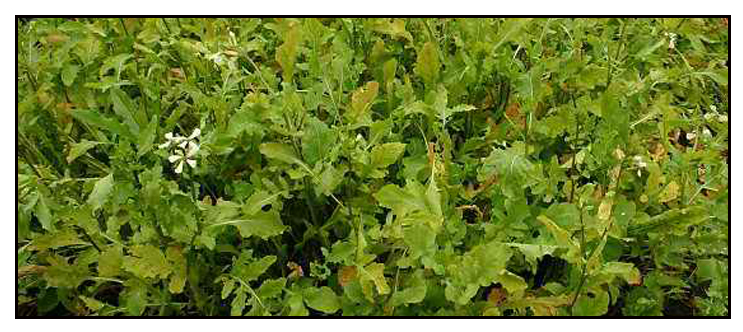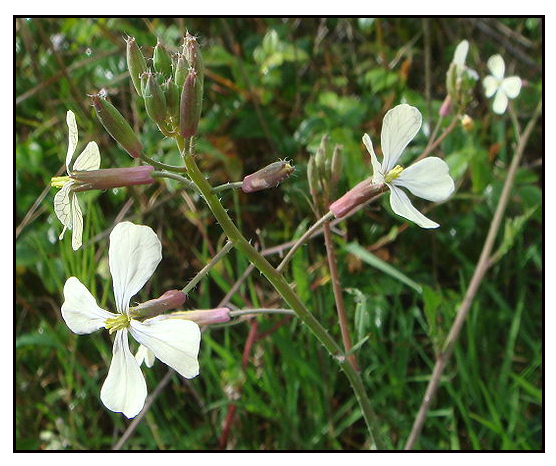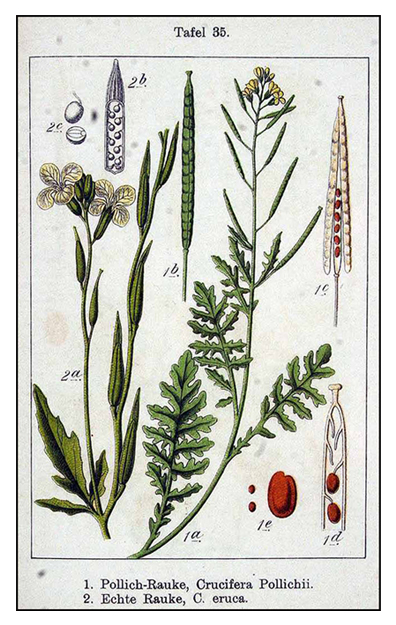
Botany
Arugula is an annual erect herb growing to a height of 2 to 3 feet. Leaves are glabrous or sparsely pilose pinnatifid, light green when young. Flowers are 1.5 to 2.0 centimeters in diameter, creamy white clawed petals, with purple veins and yellow stamens. Elongated siliques dehisce when dry, splitting to release about 20 seeds.
 Distribution Distribution
- Native to western Asia and the Mediterranean region.
-
Cultivated worldwide.
Constituents
- Phytochemical screening of various plant extracts yielded alkaloids, flavonoids, saponins, tannins, phenols, carbohydrates, steroids, and proteins. (8)
- Analysis for nutrient elements yielded 4.32% N, 0.25% P, 5.13% K, 2.95%, Ca 0.58%, Mg 799.88 mg/kg, Na 350 mg/kg, Fe 5.36 mg/kg, Cu, 40.58 mg/kg, Mn and 64.86 mg/kg. (9)
- Aerial parts contains significant amount of phenolics, particularly the seeds and leaves, 27.1±0.2 mg, 23.07±0.11 GAE/g, respectively. Phenolic analysis from stem, leaves, flowers, and seed extracts yielded vanillin (RT=3.853), ellagic acid (RT=4.04), salicylic acid (RT=19.09), resorcinol (RT=3.30), catechol (RT=3.53), quercetin (RT=18.91), benzoic acid (RT=10.4), tannic acid (RT=5.06), kaempferol (RT=8.70) and rutin (RT=9.2). (11)
- Analysis of seed oil fatty acid profile yielded six major fatty acids. The major fatty acids were palmitic acid 2.80%, stearic acid 30.8%, oleic acid 17.8%, linoleic acid 1.44%, linolenic acid 6.78%, erucic acid 47.0%. (see study below) (13)
- Phytochemical analysis of aqueous extract of fresh leaves yielded nine natural flavonoid compounds viz. kaempferol 3-O-(2''-O- malonyl-β-D-glucopy-ranoside)-4'-O-β-D-glucopy-ranoside (1), kaempferol 3,4'-O-diglucopyranoside (2), rhamnocitrin 3-O-(2''-O-methylmalonyl-β-D-glucopyranoside)-4'-O-β-D-glucopyranoside (3), 3-O- glucopyranoside (4), 4'-O-glucopyranoside (5), rhamnocitrin 3-O-glucopyranoside (6), 4'-O- glucopyranoside (7), kaempferol (8) and rhamnocitrin (9). (see study below)
(14)
- Nutrient value per 100 g. yielded: (1) Principles: energy 25 kcal, carbohydrate 3.65 g, protein 2.58 g, total fat 0.66 g, cholesterol 0 mg, dietary fiber 1.6 g, (2) Vitamins: folate 97 µg, niacin 0.305 mg, pantothenic acid 0.437 mg, pyridoxine 0.073 mg, riboflavin 0.086 mg, thiamin 0.044 mg, vitamin C 15 mg, vitamin A 2373 IU, vitamin E 0.43 mg, vitamin K 108.6 µg, (3) Electrolytes: sodium 27 mg, potassium 369 mg, (4) Minerals: calcium 160 mg, copper 0.076 mg, iron 1.46 mg, magnesium 47 mg, manganese 0.321 mg, phosphorus 52 mg, selenium 0.3 µg, zinc 0.47 mg, (5) Phytonutrients: carotene-ß 1424 µg, carotene-a 0 µg, lutein-zeaxanthin 3555 µg. (Source: USDA National Nutrient data base) (19)
 Properties Properties
- Young leaves are sweet and less peppery compared to the strong, spicy flavor of mature leaves.
-
Considered rubefacient, anthelmintic, antiscorbutic.
- Studies suggest antibacterial, antioxidant, hepatoprotective, nephroprotective, anticancer, antiulcer, anti-thrombotic, anti-platelet properties.
Parts used
Leaves, seeds.
Uses
Culinary / Edibility
- Its culinary use dates back to Ancient Greece.
- Standard table and culinary fare in Italy, France, Turkey, and Greece.
- Seeds, flowers, and pods are edible.
- Young leaves are eaten raw or cooked.
- Leaves
used as garnish on salads. Fresh leaves have a tart, bitter, and peppery flavor.
Folkloric
- Used medicinally by the ancient Greeks and Romans. Historia Naturalis records rocket as an antihelmintic, treatment for eye diseases, and aphrodisiac. (5)
- Ancient rabbinical literature records use of E. vesicaria for stimulation of salivation and improving vision. Various ancient uses recorded for acne, skin diseases, hemorrhoids, and psychological problems; as repellent, expectorant, and deodorant,
(5)
-
Use as digestive and diuretic.
- Seed oil used as aphrodisiac.
- Used for hair loss.
- Used to treat kidney and skin disorders.
- In Palestine, used for skin and reproductive diseases. For skin disease, ground leaves applied as poultice to affected skin areas.
Studies
• Cytotoxic and Genotoxic Effects of Bioactivated Metalloids: Rocket may accumulate toxic elements such as metalloids. Study evaluated the uptake of arsenic, lead, cadmium, and zinc in rocket grown in contaminated soil. Lead, cadmium, and zinc leaf concentrations were over amounts allowed by statutory limit set for metalloid contents in vegetables. In cytotoxicity assays with HL60 human leukemic cells showed the tumoricide activities of rocket decreased with increasing metalloid concentration. (3)
• Male Fertility Effects / Leaves: Study evaluated the effect of E. sativa leaves extract male fertility parameters in male albino mice. Results showed a significant (p>0.05) increase in testosterone level, sperm activity, and a significant decrease in sperm mortality and abnormalities. Histological exam showed testicular changes with a significant increase in diameter of seminiferous tubules, spermatid, and leydig cells. (6)
• Anti-Platelet / Antithrombotic: Study evaluated the effects of an aqueous extract on human platelets. Results showed E. sativa Mill. AE inhibited P-selectin expression and platelet aggregation by ADP, inhibited the release of platelet inflammatory mediators (IL-1ß, TGF-ß1, CCL5 and thromboxane B2, and inhibited NF-kB activation. In murine models, ESAE showed significant antithrombotic activity and a slight effect on bleeding time. (7)
• Antioxidant / Seed Oil: In an antioxidant evaluation of seed oil using DPPH free radical scavenging assay, the maximum antioxidative potential was exhibited by an aqueous extract with an IC50 of 126.2. (8)
• Anti-Ulcer: Study evaluated the gastric anti-ulcer properties of E. sativa on experimentally induced gastric secretion and ulceration in albino rats. Results showed E. sativa possesses antisecretory, cytoprotective and anti-ulcer activity attributed to prostaglandin mediation activity and/or through anti-secretory and antioxidant properties. (10)
• Erucin / Anticancer: Erucin (1-isothiocyanato-4-(methylthio-butane), which is metabolically and structurally related to sulforaphane, is present in large quantities in arugula. Erucin inhibits proliferation of MCF7 breast cancer cells (IC50=28 µM) in parallel with cycle arrest at mitosis and apoptosis. The suppression of microtubule dynamics by erucin and the consequent impairment of microtubule-dependent cell functions may be important in its cancer prevention activities. (12)
• Eruca Seed Oil / Erucic Acid: Erucin Erucic acid, an unsaturated fatty acid, was the predominant fatty acid in Eruca seed oil, which has desirable superior characteristics (high lubricity, cold stability, and fire resistance) for a variety of applications. Eruca seed oil exhibits suitability of the oil towards many industrial applications including biodiesel production. (see constituents above) (13)
• Flavonoid Compounds / Fresh Leaves / Anticancer: Phytochemical analysis of fresh leaves yielded nine natural flavonoid compounds. Compounds 1 (kaempferol 3-O-(2''-O- malonyl-β-D-glucopy-ranoside)-4'-O-β-D-glucopy-ranoside) and 3 (3-O- glucopyranoside) showed cytotoxic activity in 4 different human cancer cell lines: HepG2 (liver carcinoma), MCF7 (breast carcinoma), HCT116 (colon carcinoma) and Hep2 (larynx carcinoma). (see constituents above) (14)
• Bio-Protective / Seed Oil / Aflatoxin B1: Study evaluated the efficacy of seed oil to ameliorate the hazardous effect of aflatoxin B1 in male rabbits in relation to its reproductive performance. Results showed E. sativa seed oil ameliorate the harmful effects of aflatoxine, reverting all the abnormal values due to aflatoxicosis back to normal. (15)
• Antihepatotoxic / Alcohol Induced Liver Injury: Study evaluated various extracts of Eruca sativa in ethanol induced liver injury in rats. Results showed both prophylactic and therapeutic effects against experimentally induced liver injury in rats, with the prophylactic effect more potent than therapeutic effect. The activity is attributed to the treatment role against oxidative stress by increasing/maintaining antioxidant molecules and enzymes. (16)
• Antioxidant / Protective on Mercury Chloride Renal Toxicity: Mercury chloride is a known nephrotoxic agent. Study evaluated the antioxidant potential of E. sativa seeds and its protective effect on HgCl(2) induced renal toxicity. The seed extract showed a potent antioxidant effect and significant and dose dependent renal protective effect activity by preventing infliction of oxidative damage to the kidney. (17)
• Antibacterial: Study evaluated crude extracts of olive leaves and arugula seeds for in vitro antibacterial activity. Results showed antibacterial activity, with Staphylococcus aureus being the most sensitive. The arugula seeds extract had higher antibacterial activity than the olive leaves. (18)
• Antibacterial / Antioxidant / Flowers: Study evaluated the antimicrobial and antioxidant activities of solvent extract from rocket flowers. Results showed antibacterial efficiency of SERF against both gram+ and gram- bacteria, with a higher inhibition than penicillin. On antioxidant evaluation, SERF showed potent scavenging activity compared to reference curves (BHA and ascorbic acid). (20)
• Nephroprotective / Diuretic / Antioxidant: Study evaluated the nephroprotective, diuretic, and antioxidant effects of extracts of Petroleum sativum, Eruca sativa and Curcuma longa herbs in gentamicin-nephrotoxic rats. All three plant extracts exhibited a nephroprotective effect. The extracts also increased urine volume and urinary excretion of Na+ and K+, ameliorated renal tubular necrosis and increased activities of renal antioxidant enzymes in GM-intoxicated rats. (21)
• Amelioration of Alloxan Induced Diabetes / Seed Oil: Eruca sativa seed oil was tried as preventive and treatment of DM induced experimental by alloxan injection. ESS oil (0.06 ml/kg) significantly increased hepatic GSH. Daily administration of ESS oil ameliorated hyperglycemia, improved the lipid profile, blunted increase in malondialdehyde and stimulated GSH production in the liver. Study suggested that Eruca sativa seed oil could be used as antidiabetic complement in treatment of DM. (22)
• Antigenotoxic / Chemopreventive / Isothiocyanates / Human Hepatoma Cells: Study assessed the chemopreventive potency of extracts of E. sativa in HepG2 cells. E. sativa reduced the benzo(a)pyrene-induced genotoxicity in a U-shaped manner, accompanied by a significant induction of glutathione S. transferase. Chemical analysis yielded isothiocyanates erucin, sulforaphane, erysolin and phenylethyl isothiocyanate . Synergistic interaction is assumed responsible for the plant's strong genotoxicity. (23)
• Interaction with Roquette / Warfarin (Anticoagulant) Resistance: E. sativa, a common salad and herbal treatment ingredient yields 130 µg of vitamin K per 100 g. A recommendation for dietary intake of Vitamin K is 65-80 µg/day. In patients taking warfarin, increased levels of vitamin K can lead to warfarin or anticoagulant resistance. (24) (Also read: Herb/Drug Interactions)
• Improved Skin Barrier Function / Atopic Dermatitis: Atopic dermatitis is associated with skin barrier dysfunction. Study showed treatment for E. sativa extract resulted in a significant increase in transactivation activity of PPAR and suppression in expression of inflammatory cytokine. ES also promoted the expression of filaggrin related to skin barrier protection. Flavonoid constituents, quercetin and isorhamnetin, also promoted PPAR-α activity. Results suggest a potential for improving skin barrier in atopic dermatitis. (25)
• Effect of High Doses on Organ Systems: Study investigated the effect of high doses of Eruca sativa on the liver, spleen, and kidney. Megakaryocytes appeared in spleen sections indicating an activation of the immune system. Kidneys showed mild degenerative changes suggest slight adverse effect—a result that disagrees with its ability to exert a protective effect on nephrotoxic agents. (27)
• Effect on Sperm Count: Study evaluated ethanolic extracts of Eruca sativa and Zingiber officinale at doses of 200 mg/kbw for rocket and 400 mg/kbw for ginger. Results showed significant increase in sperm count for both rocket and tadalafil. (28)
• Bio-control Effect Against Hazardous Phytopathogens / Oil: Study evaluated the antimicrobial activity of E. sativa oil against phytopathogenic bacterial species and fungal species. The E. sativa oil was highly effective against all fungal isolates and high antibacterial activity against Xenorhabdus luminescens. The activity may be due to the synergistic activity of various components. (29)
• Nanoparticles / Antibacterial: Study reports on a rapid, eco-safe method of silver nanoparticles from E. sativa and Spinacia oleracea leaf extracts. The AgNPs showed antibacterial action against human pathogens, Streptococcus pneumonia and Pseudomonas aeruginosa.
(30)
• Effect of Male Fertility / Seed Oil: Study evaluated the possible effect of seed oil of Eruca sativa on male rat fertility.
Administration of seed oil at higher dose showed a decreased diameter of seminiferous tubules, reduced spermatogenic effect and number of sperms. (31)
• Promotion of Hair Growth / Propolis & Seed Oil: Study evaluated the effect of hair wax formulation containing propolis, a resinous mixture from honeybees and Eruca sativa seed oil base on hair growth potential in Wistar rats and compared with minoxidil. Results showed a significant effect on promoting hair growth as evidenced by significantly increased hair length and increased weight of new grown hairs, and improved hair follicle percentages in the anagen phase without sensitivity reaction. (32)
• Effect of Lactobacillus acidophilus Fermented Broths Enriched with Eruca sativa: Study evaluated the effects of broths of Lactobacillus acidophilus bacteria fermented with sativa seed extract in preventing gut barrier dysfunction and IL-8 release in vitro in human intestinal Caco-2 cells infected with enterohemorrhagic E. coli Results showed beneficial effects from LAB fermented with E. sativa seed extracts in gut barrier and inflammation, and suggests the LAB broths can be used as functional bioactive compounds to regulate intestinal function. (33)
• Antimicrobial / Leaves: Study showed the water extract of Arugula leaves was effective against Escherichia coli and Staphylococcus aureas. No svtivity was observed with Bacillus cereus. Also, the ethyl acetate extract showed no activity against the test bacteria. Results suggest potential for antimicrobial infections particularly in the intestinal and respiratory tract. (34)
• Bioherbicidal / Fresh Shoot Extract: Study showed spraying of aqueous fresh shoot extract of E. sativa at 80% (w/v) can be applied as natural selective bioherbicide in controlling the two annual grassy and broad-leaved weeds associated with P. sativum plants. (35)
Precautions
- Arugula is rich in oxalic acid. Patients suffering from kidneys stones are advised to used arugula sparingly, avoiding regular consumption.
- Allergic reactions, although rare, have been reported, with symptoms ranging from mild (sore lips, throat irritation, stomach cramps) to angioedema (facial swelling) and difficulty of breathing.
Availability
Cultivated.
Seeds in the cybermarket.
|

![]()




 Distribution
Distribution Properties
Properties